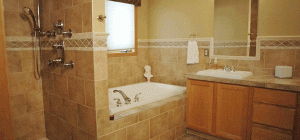Flooring is never a “one size fits all” situation, especially when it comes to choosing a new material for different rooms in your home. Not every type of flooring tile will work in every room, but many are similar enough to confuse casual buyers – some are even designed to emulate other materials.
The main material used in a set of tiles will dictate its weight, resistant to damage, heat conductivity and many other factors, all of which affect which rooms they’d be most suitable in. To make this confusing process a bit easier, we’ve created this quick guide on how to choose the best tile flooring for certain rooms in your home.
Stone Tiles
The natural water resistance of stone makes it a good choice for kitchens, but they won’t usually be suitable as a general material for more casual areas like living rooms. It can also be heavy, especially if the tiles are thick and bulky, so be wary of how much weight you’re adding if the tiles are going into an upstairs room.
Despite being similar rooms in many ways, stone works better for kitchens than bathrooms – even though they’re slip resistant, certain types of stone can be dangerous to walk on with wet feet, and the hard surface can make a fall much more dangerous.
Carpet Tiles
High-quality carpet tiles can be a versatile option for most rooms, even bathrooms: The soft material makes it difficult to slip or have a damaging fall, and regular water spills will dry up much faster than on cold stone floors. It works even better for living rooms and bedrooms, where you’re more likely to be barefoot or sitting directly on the floor.
However, carpets need regular cleaning and vacuuming to clear out dust and stains, unlike smoother materials like stone and ceramic which can simply be washed with a sponge or mop. This makes it less suitable for kitchens and rooms where untrained pets are kept, especially when it can be replaced by a rug for easier cleaning.
Laminate Tiles
Laminate can provide the appearance of another material without the downsides, making it a very style-focused choice. Good-quality laminate can mimic wood while preventing water damage and scratches, which can often be cheaper than having to constantly replace and repair the real thing – however, if you use poor laminate, you might notice that it isn’t replicating the original material very well, and it may sound or feel less accurate as it starts to wear down.
Unfortunately, the laminate can struggle to deal with large spills of water, and it’ll usually seep down between the cracks into whatever’s below, which can cause significant damage to your home if it’s used in an upstairs room.
Vinyl
Vinyl flooring is well-suited to high traffic areas that need to stay clean, like corridors and staircases. However, it also reduces footstep noise and stays comfortable underfoot, making it ideal for bedrooms and home offices. Higher-quality makes, such as the flooring produced and sold by Amtico, will mimic materials like wood and stone without using a single tile design that repeats over and over again.
Although water can still wear it down quickly, most vinyl tiles will resist moisture and humidity well, meaning that they won’t suffer damage if they’re placed just outside a bathroom. One of the only notable issues with vinyl floors are the way that they can fade in direct sunlight: using it for porch or conservatory flooring will often lead to it looking worn down in a few weeks.
Ceramic
Ceramic tiles are usually seen as a ‘jack of all trades’ tile, fitting into any room without issue. They’re very resistant, can emulate the designs of other hard materials and are very easy to clean (unless they have grooves, which can trap stains in them). Installing them can take a lot longer than other flooring types, but this is offset by the very low chance of them needing to be replaced within a given span of time.
However, they share a few downsides with stones – they’re heavy, very cold and can cause serious injuries if you fall. It can also be uncomfortable to stand on for long periods of time, which can make kitchens extremely uncomfortable to work in. This makes them most suitable for corridors, garage and any room that doesn’t get frequent foot traffic.





![Are You a Secret Hoarder? [Infographic]](https://lerablog.org/wp-content/plugins/wp-thumbie/timthumb.php?src=http://lerablog.org/wp-content/uploads/2014/11/Nation-of-Clutter-IG-v21.png&w=300&h=140&zc=1)


